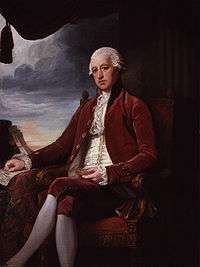Charles Jenkinson, 1st Earl of Liverpool
| The Right Honourable The Earl of Liverpool PC | |
|---|---|
|
The Earl of Liverpool by George Romney | |
| President of the Board of Trade | |
|
In office 23 August 1786 – 7 June 1804 | |
| Monarch | George III |
| Prime Minister |
William Pitt the Younger Henry Addington |
| Preceded by | The Lord Sydney (President of the Committee on Trade and Foreign Plantations) |
| Succeeded by | The Duke of Montrose |
| Chancellor of the Duchy of Lancaster | |
|
In office 6 September 1786 – 11 November 1803 | |
| Monarch | George III |
| Prime Minister |
William Pitt the Younger Henry Addington |
| Preceded by | The Earl of Clarendon |
| Succeeded by | Lord Pelham |
| Personal details | |
| Born |
26 April 1729 Oxfordshire |
| Died |
17 December 1808 (aged 79) London |
| Nationality | British |
| Spouse(s) |
(1) Amelia Watts (d. 1770) (2) Catherine Bisshopp (1744–1827) |
| Alma mater | University College, Oxford |
Charles Jenkinson, 1st Earl of Liverpool PC (26 April 1729 – 17 December 1808), known as Lord Hawkesbury between 1786 and 1796, was a British statesman. He was the father of Prime Minister Robert Jenkinson, 2nd Earl of Liverpool.
Early years, family and education
He was born in Oxfordshire, the eldest son of Colonel Charles Jenkinson (1693–1750) and Amarantha (daughter of Wolfran Cornewall). The earl was the grandson of Sir Robert Jenkinson, 2nd Baronet, of Walcot, Oxfordshire. The Jenkinson family was descended from Anthony Jenkinson (d. 1611), who was a sea-captain, merchant, and traveller and the first known Englishman to penetrate into Central Asia. He was educated at Charterhouse School and University College, Oxford, where he graduated M.A. in 1752.[1]
Political career
In 1761, Liverpool entered parliament as member for Cockermouth and was made Under-Secretary of State by Lord Bute. He won the favour of George III, and when Bute retired Jenkinson became the leader of the "King's Friends" in the House of Commons. In 1763, George Grenville appointed him joint Secretary to the Treasury.[1]
In 1766,after a short retirement, he became a Lord of the Admiralty and then a Lord of the Treasury in the Grafton administration. In 1772, Jenkinson became a Privy Councillor and Vice Treasurer of Ireland, and in 1775 he purchased the lucrative sinecure of Clerk of the Pells in Ireland and became Master of the Mint.[1]
From 1778 until the close of Lord North's ministry in 1782 he was Secretary at War. From 1786 to 1803, he was President of the Board of Trade and Chancellor of the Duchy of Lancaster, and he was popularly regarded as enjoying the confidence of the king to a special degree.[1]
In 1786 he was created Baron Hawkesbury, of Hawkesbury in the County of Gloucester, and ten years later, Earl of Liverpool. He also succeeded as 7th Baronet of Walcot in 1790. He lived in Addiscombe, Surrey and Hawkesbury, Gloucestershire. He died in London on 17 December 1808.[1]
Family
Liverpool was twice married. He married firstly Amelia, daughter of William Watts, governor of Fort William, Bengal, in 1769.[1] She died in July 1770, only a month after the birth of her only child, Robert.
Liverpool married secondly Catherine, daughter of Sir Cecil Bishopp, 6th Baronet, and widow of Sir Charles Cope, 2nd Baronet,[1] on 22 June 1782 at her house in Hertford Street, London.[2] They had one son,[2] Charles, and one daughter.[2]
Upon Lord Liverpool's death, he was succeeded by his only son from his first marriage, Robert,[2] who became a prominent politician and eventually Prime Minister of the United Kingdom. The Countess of Liverpool died in October 1827, aged 82.
Legacy
Liverpool wrote several political works but except for his Treatise on the Coins of the Realm (1805) these are, according to the 1911 Encyclopædia Britannica, "without striking merits".[1]
The Hawkesbury River in New South Wales, Australia and Hawkesbury, Ontario, Canada were named after Jenkinson shortly after he was created Baron Hawkesbury.
Notes
References
- Cokayne, George Edward (1906), [ Complete Baronetage], V, Exeter: W. Pollard & Company, p. 19 LCCN 06-23564
- Attribution
 This article incorporates text from a publication now in the public domain: Chisholm, Hugh, ed. (1911). "Liverpool, Earls of". Encyclopædia Britannica. 16 (11th ed.). Cambridge University Press. p. 408.
This article incorporates text from a publication now in the public domain: Chisholm, Hugh, ed. (1911). "Liverpool, Earls of". Encyclopædia Britannica. 16 (11th ed.). Cambridge University Press. p. 408.
Further reading
- Cannon, John (2008) [2004]. "Jenkinson, Charles, first earl of Liverpool (1729–1808)". Oxford Dictionary of National Biography (online ed.). Oxford University Press. doi:10.1093/ref:odnb/14737. (Subscription or UK public library membership required.)
 Hamilton, John Andrew (1892). "Jenkinson, Charles (1727-1808)". In Lee, Sidney. Dictionary of National Biography. 29. London: Smith, Elder & Co. pp. 309–310.
Hamilton, John Andrew (1892). "Jenkinson, Charles (1727-1808)". In Lee, Sidney. Dictionary of National Biography. 29. London: Smith, Elder & Co. pp. 309–310. - Spencer, Howard (2009), "Jenkinson, Hon. Charles Cecil Cope (1784-1851), of Pitchford Hall, Salop and Buxted Park, Suss.", in Fisher, D.R., The History of Parliament: the House of Commons 1820-1832, Cambridge University Press
